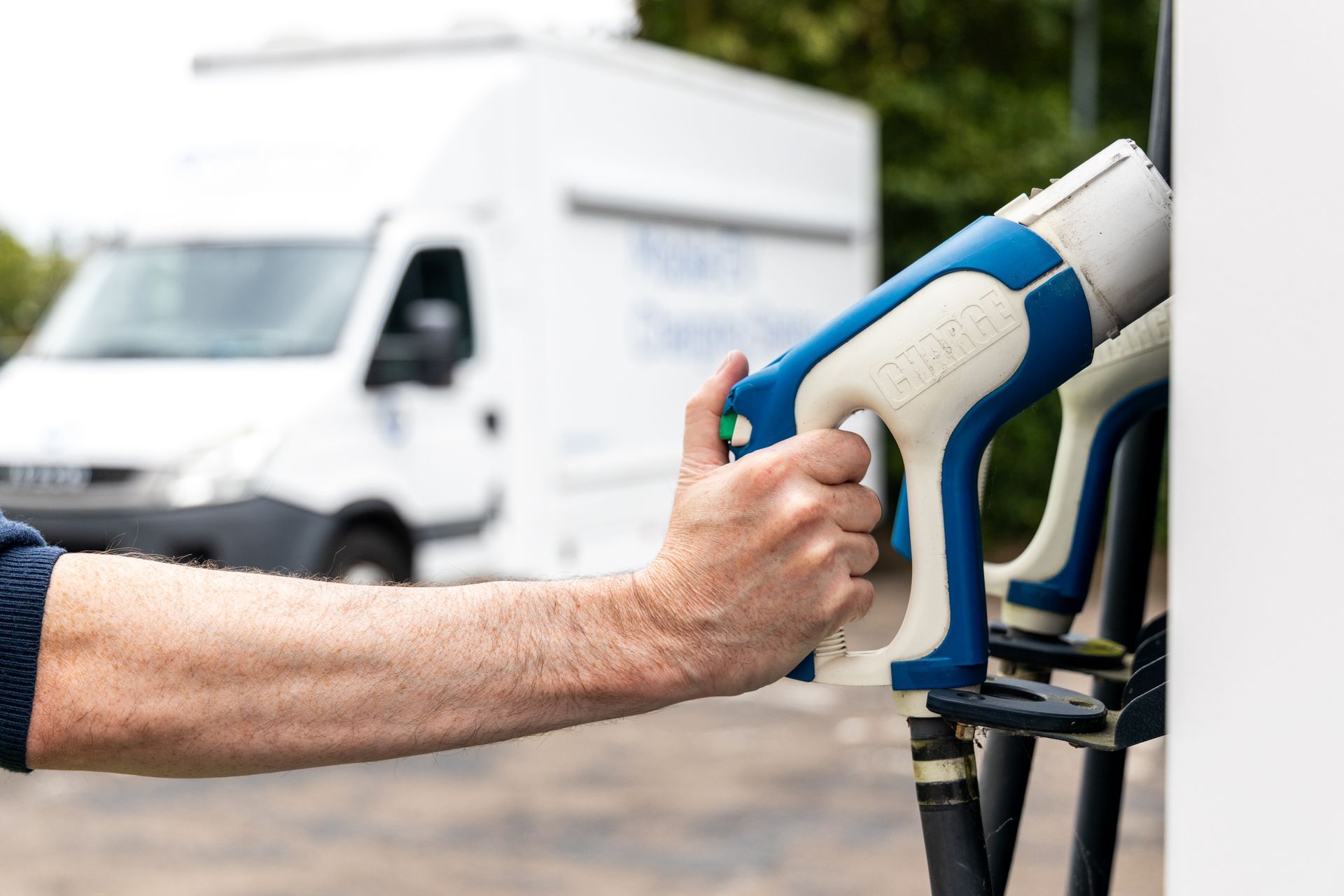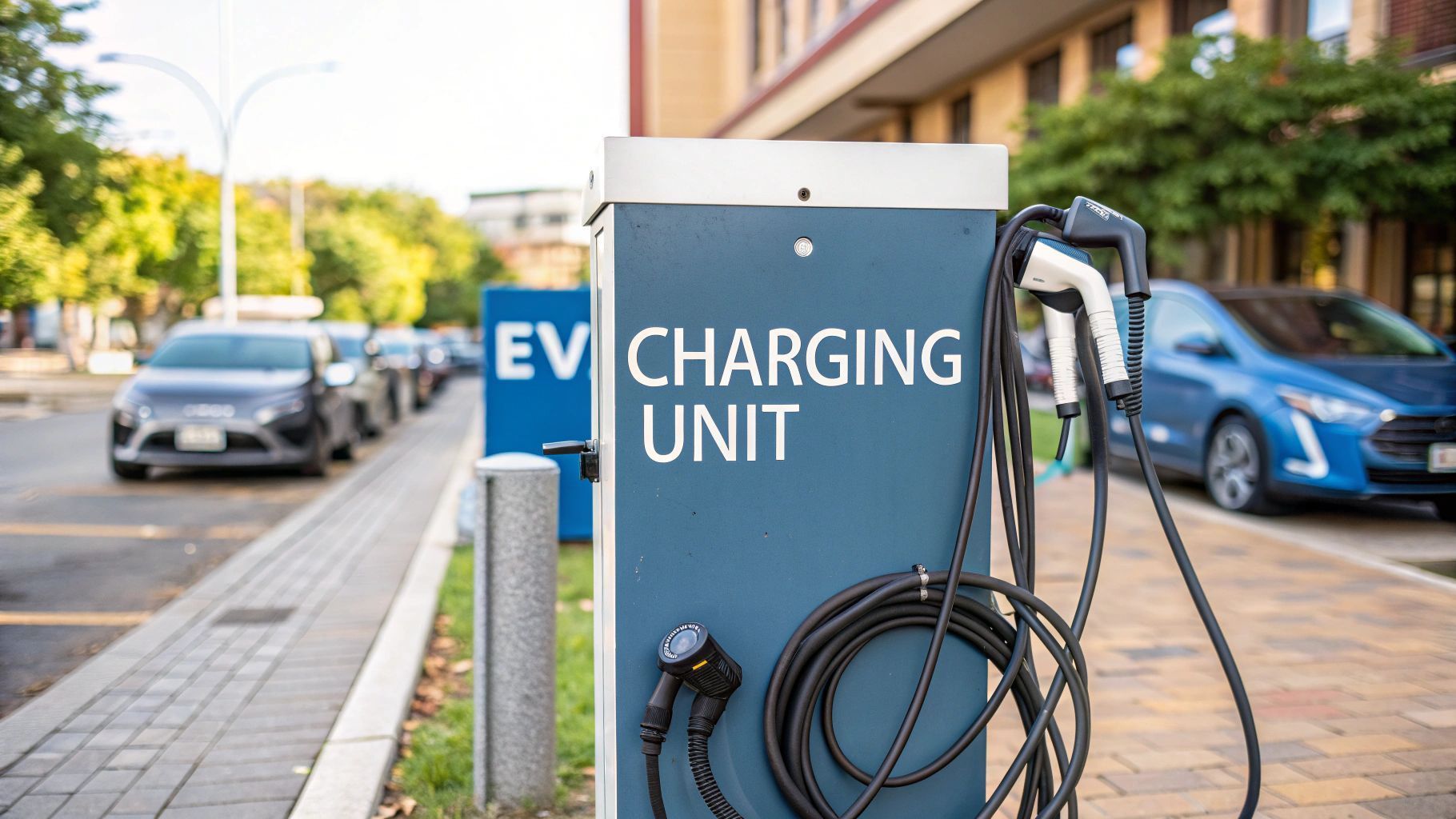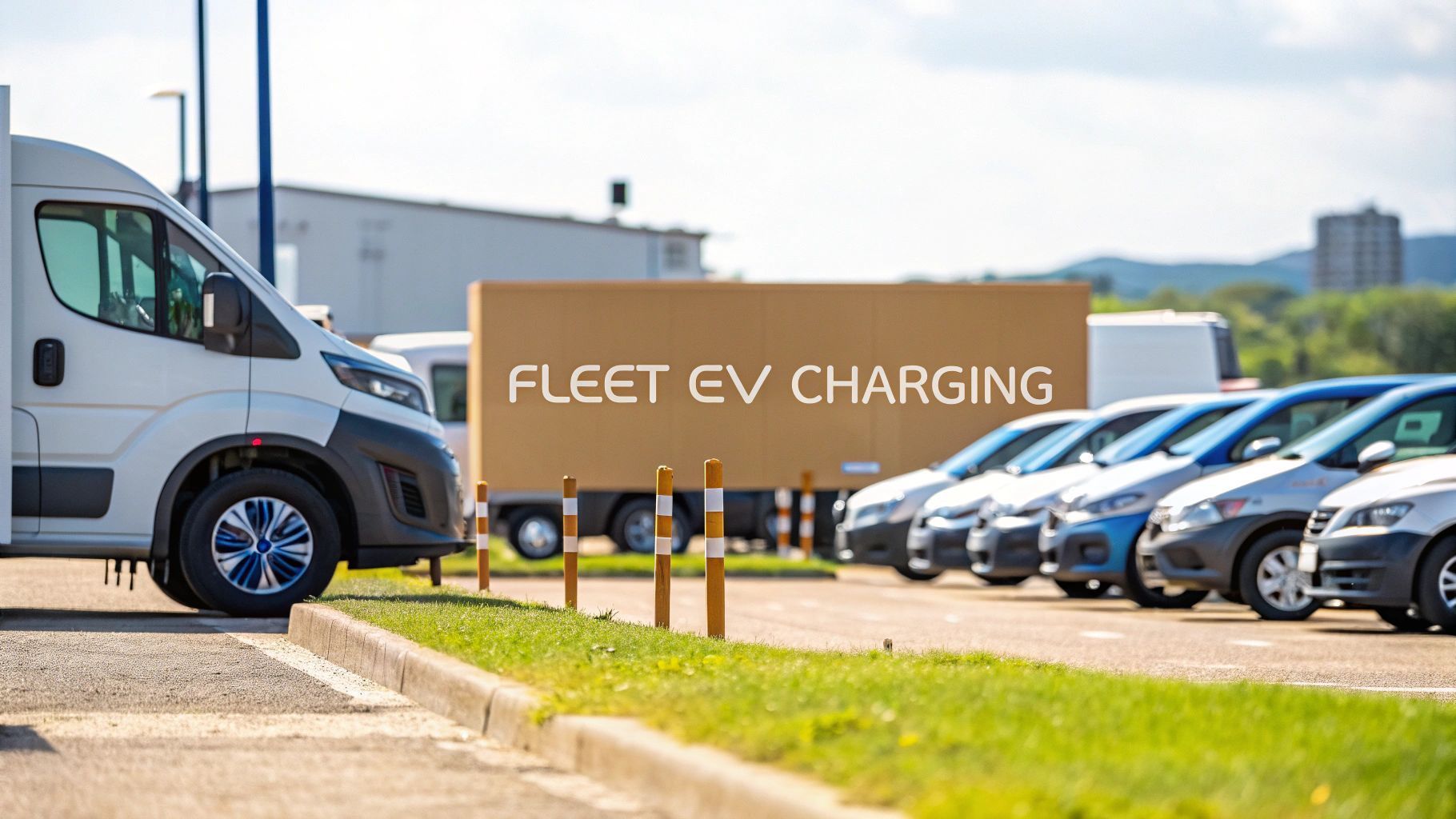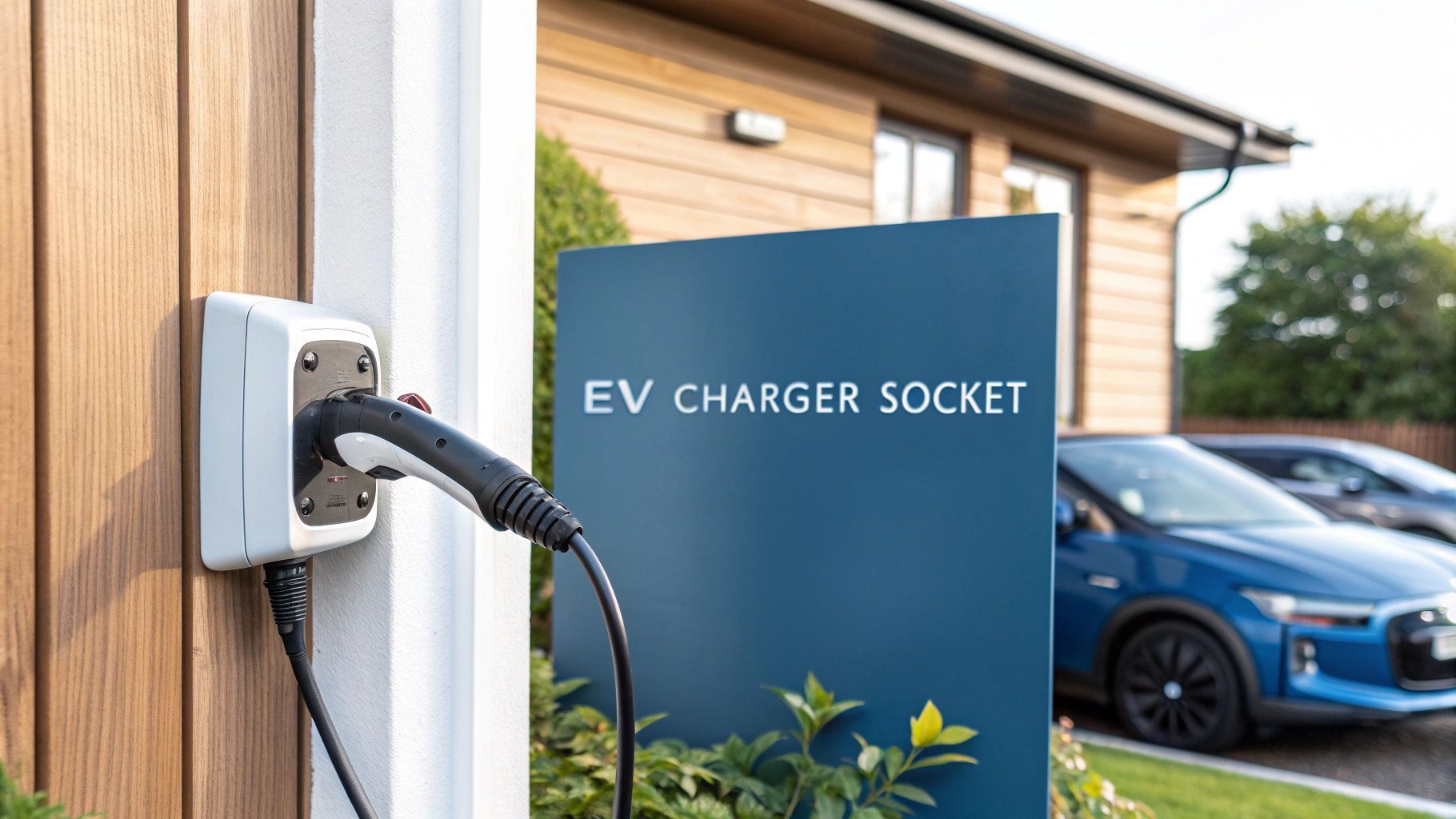Commercial EV Charging Solutions in the UK
When we talk about commercial EV charging we’re referring to the whole ecosystem of hardware, software and services that businesses use to power electric vehicles for the public, their employees or their own commercial fleets. This can range from the familiar fixed charging points you see bolted down in car parks to incredibly agile, mobile charging units that bring power directly to a vehicle on demand.
The Rise of Commercial EV Charging in the UK
The UK's roads are electrifying at a pace that’s impossible to ignore and businesses are sitting up and taking notice. The switch to EVs isn't some far-off trend anymore; it's happening right now. This shift has created a massive, urgent need for a charging network that’s both widespread and dependable. For everyone from retail park owners to logistics fleet operators, investing in commercial EV charging has quickly become a strategic priority.
What’s driving this? A few powerful forces are at play. First, corporate sustainability goals are no longer just a nice-to-have. Companies are under real pressure to shrink their carbon footprint and offering EV charging is a very public, very tangible way to show they’re serious about it. On top of that, there's a growing expectation from customers and staff who already drive EVs. A business with chargers is seen as modern, thoughtful and in tune with its audience.
Meeting the Growing Demand
But perhaps the biggest motivator is the potential for new revenue. By installing chargers, businesses can attract a valuable demographic of EV drivers who tend to stay longer and spend more while their vehicle powers up.
The UK’s infrastructure is racing to keep up. As of mid-2025, the country already has over 82,000 public charging devices spread across more than 40,000 locations . That figure represents a staggering 30% jump in just one year, showing just how fast this market is moving.
This guide will walk you through the different kinds of commercial EV charging solutions out there. We’ll focus on the two main approaches businesses are taking:
- Fixed Infrastructure: These are the traditional wall-mounted or pedestal units you’re used to seeing. They offer a reliable, permanent source of power but often come with hefty installation costs and disruption.
- Mobile Infrastructure: A more flexible approach using vehicle-mounted chargers that can be deployed anywhere, anytime. This is a brilliant, cost-effective way to test the waters, gauge demand or serve multiple locations without committing to digging up the tarmac. You can dive deeper into how mobile energy as a service offers new business opportunities in our detailed article.
Getting your head around these options is the first crucial step for any business looking to tap into this booming market. From here, we'll get into charging speeds, financial models and the practical side of installation to give you a clear roadmap.
Fixed vs. Mobile EV Charging: A Practical Comparison
When it comes to rolling out commercial EV charging, businesses are usually faced with a choice between two very different paths. The first is the traditional, well-trodden route: fixed charging infrastructure.
You’ll know these as the familiar wall-mounted boxes or pedestal units you see in public car parks and on business forecourts. They offer a reliable and powerful source of energy and once they're in the ground, they’re a permanent fixture. Their real strength is the ability to deliver high power outputs consistently, making them a solid choice for rapid and ultra-rapid charging where speed is everything.
But that permanence comes with some hefty drawbacks. The installation process can be a headache—it’s often complex and expensive, involving groundworks, potential grid upgrades and navigating the maze of planning permissions. This high initial investment and total lack of flexibility means a fixed charger is a long-term bet on a single location, which just doesn't suit every business model.
The Rise of Agile Mobile Charging
This is exactly where mobile EV charging comes into its own, offering a far more nimble and adaptable solution. The easiest way to think of a mobile charger is as a powerful battery pack on wheels, ready to be deployed wherever it’s needed most. This approach neatly sidesteps the biggest hurdles tied to fixed infrastructure.
Mobile units completely eliminate the need for costly and disruptive civil engineering works. There’s no digging up car parks or waiting months for grid connections. Instead, a business can have a powerful charging solution up and running almost immediately, allowing it to react quickly to market demands and customer needs.
The infographic below shows the different charging levels available, which can be delivered by both fixed and mobile solutions.

This visual really hammers home the significant difference in charging speed between Level 2 and DC Fast Charging, showing exactly why rapid solutions are so critical for commercial success.
Unlocking New Revenue Streams with Flexibility
The true strategic advantage of mobile charging lies in its flexibility and the potential for some serious financial returns. An operator is no longer chained to a single physical location. They can move their charging asset to where the demand is highest at any given time, maximising its use and, ultimately, its profitability.
For instance, a mobile charging unit could serve a busy office park during the 9-to-5 grind, then simply relocate to a residential area or a retail centre in the evening or over the weekend. This ability to follow the demand transforms the charger from a static utility into a dynamic, hard-working business tool.
Mobile charging allows an operator to earn revenue across multiple locations with a single asset. A unit can generate income from fleet charging in the morning, roadside assistance in the afternoon and event charging in the evening, significantly boosting its return on investment.
This adaptability also lets operators test the waters in new areas without committing to a full-scale, expensive installation. Better yet, they can provide a premium, on-demand service for emergency roadside assistance, creating a high-margin revenue stream that fixed chargers simply can't touch. When you add it all up, the lower initial outlay and versatile earning potential make mobile charging an incredibly compelling financial proposition for savvy operators.
How to Profit from Mobile EV Charging

Mobile EV charging isn't just a clever service—it's a seriously dynamic business model. A fixed charger is bolted to one spot, earning money only when someone plugs in. A mobile unit, on the other hand, is a roving asset capable of generating revenue from different customers and locations all in a single day. This adaptability is exactly where its earning power comes from.
The most straightforward route to revenue is simple pay-per-charge fees . An operator can drive to a customer, deliver the needed energy and charge a set rate per kilowatt-hour (kWh). This model is a perfect fit for on-demand services where people are happy to pay a premium for convenience.
But you don't have to rely on one-off jobs. You can build a much more stable business with subscription models, which are a massive draw for commercial clients like delivery firms or taxi services. A business could pay a flat monthly fee for scheduled daily top-ups for its entire fleet, giving you a predictable, recurring income stream. It’s a game-changer for businesses, as many are now revolutionising fleet management with on-demand rapid EV charging to slash vehicle downtime.
Diversifying Your Revenue Streams
The smartest operators don't just stick to one income strategy; they blend several. The real financial magic happens when you deploy a single mobile unit across multiple scenarios, each with its own pricing.
Picture a typical day. Your unit could start the morning serving an office park, offering employees a convenient charge while they work. By the evening, that same unit could be parked in a residential area with poor off-street parking, providing an essential overnight charging service. This multi-location approach keeps your asset constantly working and earning.
One of the biggest financial wins in mobile charging is the ability to set premium rates for specialised services. Emergency call-outs for drivers with a dead battery can command much higher fees than a standard booking. A driver's misfortune can become your high-margin opportunity.
Modelling a Profitable Day
So, what could a realistic day's work look like for one mobile unit? Let's break it down:
- Morning (7 am - 11 am): You’re servicing a local delivery fleet on a contract. The job is to deliver 80 kWh across four vans before they head out. At a contract rate of 70p per kWh , that’s £56 in the bank.
- Afternoon (1 pm - 4 pm): You handle two on-demand public call-outs. Each driver needs about 25 kWh to get home. At a premium rate of £1.00 per kWh plus a £25 call-out fee , you’ve just made another £100 .
- Evening (6 pm - 10 pm): You’ve positioned the unit at a busy retail park. You serve multiple shoppers, delivering a total of 100 kWh . At a standard public rate of 85p per kWh , that’s another £85 .
In this one day, a single mobile unit could bring in £241 in revenue. It’s a powerful demonstration of the return on investment you can get when you deploy your asset strategically.
And remember, this entire operation sidesteps the enormous costs tied to fixed chargers—things like grid upgrades, planning permission battles and disruptive groundworks. That makes the whole venture more profitable right from the very beginning.
Potential Revenue Models for a Mobile EV Charger Operator
Thinking about how to structure your pricing? There are several proven models you can adopt, either individually or as a combined strategy to maximise your unit's earning potential. Each one targets a different customer need, from urgent roadside assistance to routine fleet management.
| Revenue Model | Description | Target Customer | Potential Pricing Structure |
|---|---|---|---|
| On-Demand Pay-Per-Use | Customers request a charge via an app or phone call and pay for the energy delivered, plus a service fee. | Individual EV drivers, tourists or anyone needing a top-up. | Per kWh rate + call-out fee (e.g., £0.90/kWh + £20 fee). |
| Fleet Subscriptions | Businesses with EV fleets pay a recurring monthly or annual fee for scheduled charging services. | Delivery companies, taxi services, corporate car pools. | Fixed monthly fee per vehicle or a discounted bulk kWh rate. |
| Event Services | Providing temporary charging infrastructure for festivals, trade shows or outdoor events. | Event organisers, venue managers. | Flat day rate or a revenue-share agreement with the organiser. |
| Emergency Roadside Assistance | A premium service for drivers who have run out of charge and are stranded. | Stranded EV drivers, breakdown recovery services. | High flat-rate call-out fee plus a premium per kWh rate. |
| Partnership with Property Managers | Partnering with residential or commercial properties that lack charging infrastructure. | Apartment blocks, office parks, retail centres. | Monthly retainer from the property owner or a dedicated rate for tenants. |
By mixing and matching these models, an operator can create a resilient business that isn’t reliant on a single source of income. This flexibility is what truly sets mobile charging apart as a profitable venture in the growing EV market.
Choosing the Right Charging Speed for Your Needs
Picking the right speed for your commercial EV chargers is one of the most critical decisions you'll make. It directly shapes customer satisfaction, how quickly vehicles can get back on the road and your overall return on investment.
Get this wrong and you could end up either frustrating drivers with painfully slow service or overspending on power you don't actually need.
Think of it like filling a water tank with different-sized hoses. A slow 7kW charger is your reliable garden hose—it gets the job done steadily over a long period. A rapid 50kW charger is more like a firefighter's hose, delivering a huge volume in a short burst. The key is to match the hose to how long the vehicle will be parked at your location.
Matching Speed to Dwell Time
The concept of dwell time —how long a vehicle stays parked—should be your number one guide. There's no point installing an expensive, ultra-rapid charger at a location where cars are left for eight hours. Conversely, a slow charger at a motorway service station will only create long queues and unhappy customers.
Understanding this relationship is what allows you to choose the most cost-effective commercial EV charging solutions for your business.
- Workplaces and Hotels: These spots are perfect for slower 7-22kW 'fast' chargers. Employees and guests park for hours on end, so a gradual top-up overnight or during the workday is more than enough and keeps installation costs down.
- Retail Parks and Supermarkets: Here, customers might stay for an hour or two. A 'rapid' charger of 50kW or more is essential. It delivers a meaningful charge in a short time, giving EV drivers a real reason to visit and spend more.
- Motorway Services and Fuelling Stations: Dwell time is minimal. Drivers want to charge and go, making 150kW+ 'ultra-rapid' chargers the only sensible option to ensure a fast turnaround and keep traffic flowing.
The UK's Shift Towards Faster Charging
The trend across the UK is clearly moving towards faster charging to meet commercial demands and slash driver waiting times. At the start of 2025, out of roughly 73,334 public EV charging devices, around 14,448 were rated at 50kW or above.
By mid-2025, that figure had already climbed to approximately 16,677 devices . This shows a clear focus on deploying higher-speed commercial EV charging solutions. You can dig into the data yourself on the government's official charging map.
Choosing the right charging speed isn’t just a technical decision; it's about understanding human behaviour. The goal is to provide a charge that fits seamlessly into your customer's journey, whether that's a full battery over a week-long hotel stay or a quick 20-minute boost on the way to a meeting.
Ultimately, by analysing your customers' typical dwell time, you can make a smart decision that serves their needs and your business goals. This ensures you invest wisely, providing a valuable service without paying for speed that will simply go unused.
Navigating UK Grants and Installation Logistics

Putting commercial EV charging in place is a significant investment but UK businesses don't have to go it alone. The government has rolled out a range of grants and incentives designed to soften the financial hit and make the switch to electric much easier. These schemes are all about speeding up the rollout of charging infrastructure across the country.
The best-known of these is the Workplace Charging Scheme (WCS) . It's a straightforward voucher-based system that gives eligible businesses a hand with the upfront costs of buying and installing new charge points. The scheme can cover up to 75% of the total cost, capped at £350 per socket for a maximum of 40 sockets . It’s a real game-changer for many businesses.
Beyond the big national schemes, it's also worth looking closer to home. Many local authorities offer their own grants to encourage EV uptake in their patch. These can vary wildly from one council to the next, so a quick check with your local authority could uncover some valuable extra support.
Understanding the Installation Process
Getting the funding sorted is just the first step. The practical side of installation needs careful thought, as it’s a lot more involved than just plugging in a new bit of kit. The whole process involves several critical stages to ensure everything is safe, compliant and working as it should.
It all kicks off with a detailed site survey . A qualified installer will visit your property to pinpoint the best spots for the chargers and, crucially, to check your existing electrical capacity. This is a make-or-break moment, as it determines whether your current power supply can handle the extra load or if you’ll need a potentially costly grid upgrade.
The timeline for installing fixed commercial chargers can be surprisingly long, often stretching from several months to over a year. It’s a step-by-step process that moves from planning and site selection through to permits, ordering equipment and finally, the installation itself.
Once the survey is done, the next hurdle is the paperwork. While many smaller installations fall under ‘permitted development rights’, bigger projects or those in sensitive areas like conservation zones might need formal planning permission. This is why working with a certified, experienced installer from day one is so important—they can guide you through the maze and make sure all the work meets the required safety standards.
Regional Differences in Infrastructure
The UK's charging landscape is anything but uniform; there are huge variations from one region to another. These differences can shape both the challenges and the opportunities for businesses looking to install new commercial ev charging solutions . The availability of grid capacity and existing infrastructure can change dramatically depending on where you are.
Greater London, for instance, is the undisputed leader, home to around 30% of all public chargers in the country. By July 2025, the capital had more than 25,500 public EV charging devices —that's more than double any other UK region.
This concentration of infrastructure in urban centres means competition is fierce but so is driver demand. On the flip side, rural or less developed areas might present a golden opportunity for a business to become the local go-to charging destination. Getting to grips with these local nuances is key and you can learn more by exploring our guide to the UK’s public EV charging point networks in 2025.
Got Questions About Commercial EV Charging? We've Got Answers
Getting into the world of commercial EV charging can feel like a big step and it's natural to have a few practical questions. To wrap things up, we’ll tackle some of the most common queries businesses have, giving you clear, straightforward answers to help you move forward with confidence.
How Much Does Installing a Commercial EV Charger Cost in the UK?
This is the big one and the honest answer is: it varies wildly. The final cost depends on the type of charger you choose and how complex your site is. For a basic 7kW wall-mounted unit, you might be looking at £1,000 to £2,500 per charger, including a standard installation.
But if you’re thinking about a rapid 50kW DC charger, it’s a much larger investment. The unit alone often ranges from £20,000 to £50,000 and installation can add thousands more, especially if you need to do any groundworks or upgrade your connection to the grid. Mobile charging units flip this on its head, with a higher initial equipment cost but almost no site installation expenses.
It’s so important to look beyond just the hardware price. When you're budgeting, always factor in the ongoing costs like software subscriptions, maintenance contracts and any potential grid upgrade fees.
Can I Set My Own Prices for Customers?
Yes, absolutely. Once the charger is yours, you have complete control over your pricing strategy. This is all managed through the charger’s back-office software platform.
You can set a price per kilowatt-hour (kWh), charge a flat fee for each session, bill by the minute or even create a mix of these models. Many businesses get creative, setting up different price tiers for employees, the public and registered members. This flexibility means you can build a strategy that covers your electricity costs, generates a healthy profit or simply acts as a great perk to draw more people to your business.
What Kind of Maintenance Do Commercial EV Chargers Need?
Commercial chargers are built to last but like any hardworking bit of tech, they need regular attention to stay safe and reliable. This usually involves an annual safety inspection by a qualified electrician, routine software updates and a good physical check for any wear and tear.
A solid maintenance contract with your provider is a very smart move. It typically covers remote diagnostics to spot problems before they cause an issue, on-site repairs and preventative checks to keep downtime to an absolute minimum. If you opt for mobile chargers, you'll also need to think about standard vehicle maintenance. A little proactive care goes a long way in keeping your revenue flowing and your customers happy.
Do I Need Planning Permission to Install Commercial Chargers?
In many cases, you might not. In England, installing wall-mounted chargers or upstanding units below a certain size often falls under ‘permitted development rights’. In simple terms, this means you can get on with it without going through the full planning permission process.
But there are some important exceptions. You will almost certainly need permission if your building is listed, sits within a conservation area or if the installation requires major construction work. The best advice is always to have a quick chat with your local planning authority before you start any work. It ensures you’re fully compliant and avoids any headaches down the line.
Ready to explore the most flexible and profitable commercial EV charging solutions available? ZAPME offers cutting-edge mobile charging units that eliminate installation headaches and open up new revenue streams. Discover how our Energy as a Service model can power your business forward by visiting https://www.zapme.biz.











